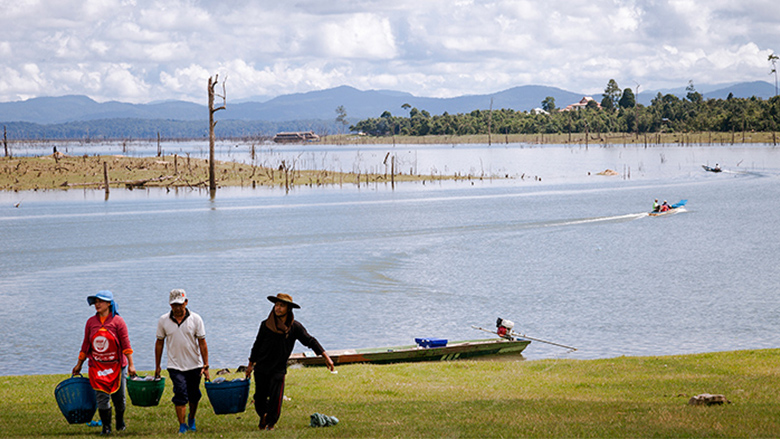The Nam Theun 2 multipurpose development project (NT2) is one of Lao PDR’s largest and most complex hydropower projects. It is jointly implemented by the Nam Theun 2 Power Company (NTPC) and the government of Lao PDR and financed by 27 parties, including the World Bank Group (WBG) and the Asian Development Bank (ADB).
News:
- The Resettlement Implementation Period was closed in July 2018, following the recommendation of the Panel of Experts. Letters confirming closure from the Panel of Experts and Government of Lao PDR are available. The World Bank Nam Theun 2 Social and Environment project closed on December 31, 2017. Read our statement on project closure.
- The independent international Environmental and Social Panel of Experts visited Lao PDR for their 28th mission in June-July 2018. Their report (#28) is available here. You can also read a response to this report from the Ministry of Energy and Mines, on behalf of the Joint Working Group, here. Previous reports from the Panel of Experts are available.
- The Nation, September 10, 2018: Lao PM holds up Nam Theun 2 dam as successful hydro model
Results:
- The 1070 MW Nam Theun 2 hydropower plant began commercial operations in 2010 and applies rigorous international safety standards. The power generated is exported to Thailand (1000 MW) and used domestically (70 MW).
- Over $170 million in revenues were received by the Lao treasury in income from the project between 2010 and 2017. In keeping with the project’s legal agreements, these were all allocated to projects and programs contributing to poverty reduction or environmental management. Education and health sectors received the largest shares of revenues, with 39% and 14% of total revenues disbursed. Some examples of programs that have benefited include School Block Grants and the Health Equity Fund. Revenues also contributed to road construction, repair, and maintenance, as well as rural electrification.
- NT2 required the resettlement of around 6,300 people in 15 villages on the Nakai Plateau in Khammouane Province in Lao PDR. In consultation with project developers, resettlers were provided housing and community infrastructure and the project instituted livelihoods programs in fisheries, agriculture and livestock, forestry and small enterprises (off-farm activities) to upgrade incomes and living standards. Some results of the resettlement process include:
- Living standards have improved, particularly in the areas of health and education. Primary school enrollment is now 94%, compared to 31%, and stunting has dropped by 9 percentage points. 98% of people surveyed say that their lives are as good or better than before.
- 97% of households have doubled their pre-project monetary incomes, meeting the target set in the Government’s Concession Agreement with the company. Support (such as food supplements) is in place for those vulnerable households who have not yet reached this level. 99.6% of households now report having savings, compared to 21% in 2006.
- Access to markets and travel has improved with paved roads cutting the amount of time it takes to travel from Nakai district to Thakhek, the provincial capital, from half a day, to only one hour.
- Development of commercial forestry in the resettled area did not meet expectations and yielded negligible dividends to resettlers. Recent consultations with villagers redirected management of these resources to grazing, non-timber forest products, and conservation.
- Support was also provided to villages downstream of the power station, and upstream of the Nakai Reservoir to compensate for impacts related to changes in river flows on fishing incomes, river gardens and other assets, and consequent changes in income and protein intake. The formal downstream program concluded in 2012. However, a strengthened Adaptive Management Committee is in place to monitor fish levels and erosion, and the local government continues to support the most affected households through village development planning.
- $1.3 million from the project is allocated each year to protection of the watershed and the Nakai Nam Theun National Protected Area, which is scheduled to become one of Lao PDR’s first national parks. Managing the 4000 km2 area has been challenging, as the whole country experienced increasing pressure to its biodiversity, with conservation experience and institutions not yet well developed in Lao PDR. However, renewed involvement of the Ministry of Agriculture and Forestry, and a Consortium of Technical Experts from Lao and international NGOs are helping to reinvigorate the watershed protection authority to ramp up conservation activities and support communities.
- The Nam Theun 2 project now moves into a new phase. Recognizing that adaptation and sustainability can take a generation, support to project areas continues. Led by the district government under Lao Sam Sang principles of village self-reliance, development partners remain engaged, including an agriculture project from Agence Française de Développement. In addition, the Nam Theun 2 Power Company will finance the Nam Theun 2 Development Fund to be jointly managed through the village development planning process.
Project component factsheet updates (2017):
Update #1: Resettlement (August 2017)
Update #2: Revenue Management (September 2017)
Update #3: Downstream Program (November 2017)
Update #4: Nakai Nam Theun Watershed (December 2017)
